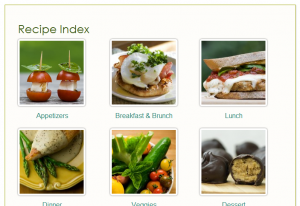These templates/snippets will work only if you have the Genesis Framework installed and a child theme active. This will provide a graphic / image based index of your photos or recipes categories.

Image Index from FramedCooks.com
Before you start, you’ll need this:
- FTP access
- Text / Code editor
- All posts for this index in one big category, for example, “Recipes” with all the sub-categories below that. Each post/recipe should be placed in one of the sub-categories.
- The ID of the main category
1. Create the Main Image Index Page
Create a new Page (not post) and simply create a gallery of your favorite images – one representing each sub-category. In the above image, the sub-categories were Appetizers, Breakfast & Brunch, Lunch and so on. Then style appropriately. Link each of these images to your sub-categories.
Now we’ll create the templates for each sub-category to automatically display all the latest yummy-ness or photos.
2. Test for child categories using a custom function
Add this to your child theme’s functions.php:
//by ValenDesigns.com
// If is category or subcategory of $cat_id
if (!function_exists('is_category_or_sub')) {
function is_category_or_sub($cat_id = 0) {
foreach (get_the_category() as $cat) {
if ($cat_id == $cat->cat_ID || cat_is_ancestor_of($cat_id, $cat)) return true;
}
return false;
}
}
3. Add an archive.php template to Genesis child theme
Add this file in its entirety to your child theme folder and name it archive.php. If you already have an archive template, this will NOT work – you’ll need to add these functions carefully to the existing file so you don’t disable current functions.
';
$title .= single_term_title('', false );
$title .= '';
echo $title;
}
//list subcategories or siblings
function dswp_listsubcats () {
foreach (get_the_category('') as $category);
$cat = get_query_var('cat');
$cat_id=$category->cat_ID;
$child_cats = get_categories('child_of='.$cat);
if ($child_cats) { $args = array(
'title_li' => '',
'depth' => 1,
'echo' => 1,
'child_of' => $cat
); ?>






